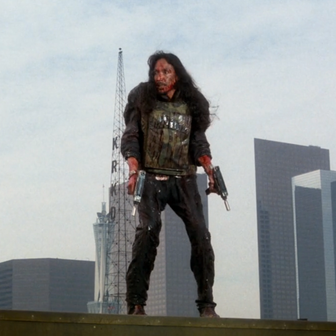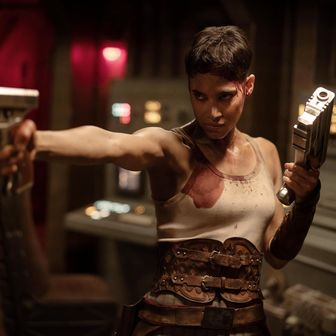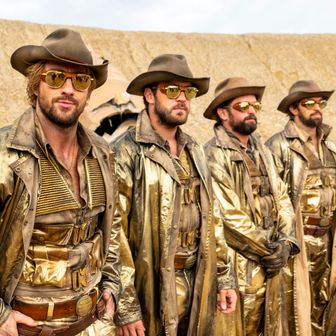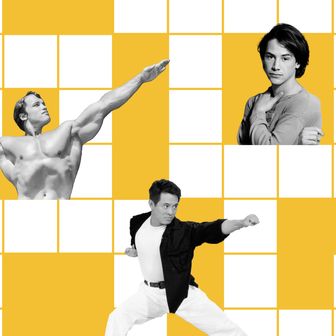
There isn’t an agreed-upon name for the fight move I have in mind. It’s a flying-scissor takedown, or a thigh crush, or a variation on a hurricanrana. Whatever it’s called, you’d know it if you saw it, because it’s become an inescapable part of an action heroine’s fight repertoire. A character clamps her (and it’s inevitably a her) legs around an opponent’s neck and uses the momentum of her body to power him (and it’s almost always a him) to the ground. Sometimes she vaults through the air to get in position, as is the preferred approach of Scarlett Johansson’s Natasha Romanoff in the Marvel movies. Sometimes she climbs her foe like a jungle gym, à la Rebecca Ferguson’s Ilsa Faust in the Mission: Impossibles. Occasionally, circumstances demand that she linger in place in order to choke a guy out or snap a neck, the way a chained-up Harley Quinn (as played by Margot Robbie) does in The Suicide Squad.
The Action Edition
In real life, there have to be a dozen more direct, less cool-looking approaches to attacking someone who’s bigger and burlier, but Hollywood has settled on the collision of crotch to face. We all have muscles, but arms (and the punches that get launched by them) belong to the realm of brawn, which remains stubbornly coded as masculine. Legs, on the other hand, are traditionally an asset to be admired on women, communicating litheness and limberness rather than visible strength. How do you choreograph a scene in which a woman, especially one of sylphlike screen proportions, goes toe-to-toe with an enemy twice her size? Rather than slug it out, you have her do something acrobatic, impressive, and a little bit provocative instead — let’s call it killer gams.
While instances of killer gams have been around for decades — Bridgette Wilson-Sampras does a game-inspired version in Mortal Kombat (1995), and Charlize Theron performs a brusque take early on in Æon Flux (2005) — you can trace the emergence of the move as a flashy go-to in women’s combat choreography by looking at Mystique in the X-Men movies. When played by Rebecca Romijn in the early 2000s, it wasn’t part of the character’s repertoire, though she fought primarily with her legs using a dancerly style that involved sultry spinning kicks and wire-assisted leaps and underscored the femme-fatale nature of a character who is perpetually nude. But by 2014’s Days of Future Past, when she’s played by Jennifer Lawrence, Mystique is constantly throwing her ankles around a soldier’s neck to take him down, though it was rendered more bone-crushingly utilitarian than alluring.
You can chalk Mystique’s evolution as a fighter up to the increasingly chaste nature of the American blockbuster, where the godlike bodies of stars and the stunt performers filling in for them are displayed mainly in the context of violence. But this also highlights the contradictory quality of the killer gams. It’s a move with actual grappling antecedents, from a banned judo throw to the flying armbar in jujitsu. Its roots actually lie in lucha libre, and similar maneuvers can be seen all over pro wrestling. And yet, onscreen, its use is definitely gendered, to the point where a video that made the rounds online a few years ago labeled it the “between-my-legs takedown” and scolded it as sexist. That condemnation feels harsh, though as countless horny YouTube compilations attest, there is an inherently titillating quality to the stunt — legs, head, etc. — despite the fact that it now tends to get performed straight-faced, as though it were purely practical in nature. It’s as though the sensuality that has disappeared from elsewhere on the big screen has been sublimated into this spectacle of swiveling movements and entangled forms that insists it’s just business.
Whatever its athletic inspirations, the move also owes something to the tradition of a woman crushing someone with her thighs onscreen in ways that do explicitly evoke sex. In its earliest appearances, this move was a girl-on-girl exhibition, the stuff of cat-fighting in Mack Sennett shorts and noir exploitation movies. When Pris (Daryl Hannah) fights Deckard (Harrison Ford) in 1982’s Blade Runner, she locks her lower limbs around his neck and then grabs his head like she’s hoping to pull it off, as though reclaiming her created purpose as a replicant pleasure model for the sake of rebellion. Lena Olin’s femme fatale laughs with a borderline erotic delight when strangling Gary Oldman between her legs from the backset in Romeo Is Bleeding in 1993, while two years later, Xenia Onatopp, the paraphiliac henchwoman played by Famke Janssen in the Bond film GoldenEye, would be even more direct, gasping orgasmically while asphyxiating men between her thighs. The satirical series The Boys followed this trope through to its end point with a sequence in which a disgraced superhero played by Brittany Allen accidentally explodes the skull of the man whose face she’s sitting on while climaxing during oral sex.
Compared to these scenes, the contemporary killer gams is downright decorous, even if the showstopping slit required to enable it in the dress Ferguson wears in Mission: Impossible — Rogue Nation isn’t. When Ilsa Faust performs the move in front of the villainous Solomon Lane (Sean Harris), it’s strictly to demonstrate her formidability. The henchman who’s brought her in lays hands on her, and in response, she grabs his arm, steps on his thigh, straddles his shoulders, spins him effortlessly to the floor, and gracefully comes up having relieved him of his gun. In interviews, Ferguson has described her character’s trademark technique as catlike, though for the stunt professionals I spoke to, the best way to talk about it is as a dance, because it’s actually a joint effort between the performer on top doing the spin and the post person on the bottom providing the base. A size difference is key to making it all look effortless and dynamic. As director and fight coordinator J.J. Perry puts it, “If I’ve got a six-foot-eight, 300-pound post man” — the performer getting crushed — “it’s going to be way easier for him to manipulate a 110-pound actress than it is a 200-pound actor.”
For stunt workers, killer gams doesn’t have a name so much as a shorthand — it’s the Widow move, or, in acknowledgment of the woman who performed it for the Scarlett Johansson character, the Heidi Moneymaker one. Moneymaker, who doubled for Johansson from Iron Man 2 through Black Widow, is proud of the maneuver, which she says belongs to a lot of people, from the choreographers who put it together to Johansson herself, who performed parts of it for the films. (Killer gams lends itself well to camera trickery — if your main actor isn’t able to do the entire move herself, you can shoot her doing the entry and landing, and in between cut to a top or wide shot with a stuntperson doing the tougher part.) It’s Moneymaker’s sister and fellow stunt performer Renae who performed the move as Mystique in Days of Future Past, in an homage to her sibling. But even Moneymaker admits that killers gams is “probably overused at this point.” “You can see a lot of girls now, on their reels, when they’re doing fight stuff — they want to show that they can do that move, that they could be somewhat acrobatic,” she says.
Jénel Stevens, who did fight choreography and doubled for Viola Davis in The Woman King, says she’s tried to move away from killer gams for those reasons. She finds it useful — “it’s a move made to use momentum, so that it’s a little bit more believable to be able to throw a guy,” she says. “We want to see the woman beat the biggest dude in the room.” But she, like almost all of the women stunt professionals I spoke to, talked about being eager to see more gritty, situation- and character-driven fight choreography for female characters. “The wow factor to me is still there,” stunt performer, actor, and second unit director Angelica Lisk-Hann says of killer gams. “But I’m looking forward to seeing what the next move is. It’s got to serve the story, too. You don’t just run around and wrap your legs around somebody’s neck for no reason.”
A movie that does actually provide ample reason for leg-wrapping is 2011’s Haywire, which features a fight between mixed martial artist turned actor (turned Elon Musk–funded plaintiff) Gina Carano and actor Michael Fassbender. Choreographed by Perry, it begins with Fassbender’s character sucker-punching Carano’s in the back of the head and concludes with him dead. In between, furniture is smashed, bodies are thrown against the walls, and the performers give an astounding re-creation of what it might actually look like for two people to try to kill one another with their bare hands. It’s a sequence that toys with the sexualized undercurrent in so many mixed-gender fights without replicating it — it takes place in a hotel room, the characters are dressed in formalwear, and the combat brings them to bed together in the least libidinous clench possible. It’s there, as Fassbender scrambles to retrieve a gun from under the mattress, that Carano stops him by putting his head in a leglock until he passes out, gasping with effort and yanking her opponent in by the hair as his face turns red and his eyes bug out. It’s killer gams, rendered in a brutally credible fashion. Maybe it’s not that the move has gotten stale so much as that it’s ready for a different context — one that makes you not just admire it, but believe it.














